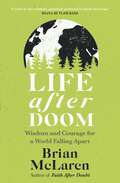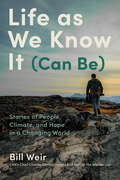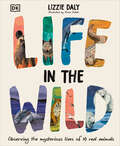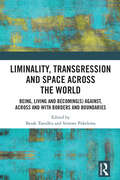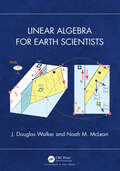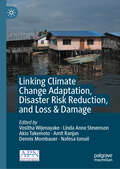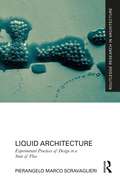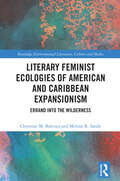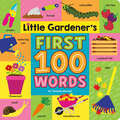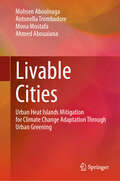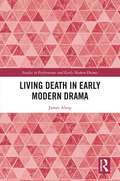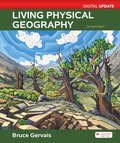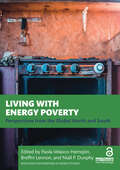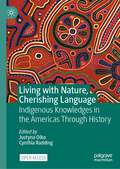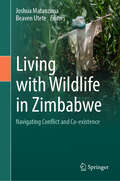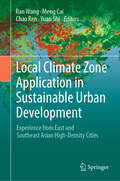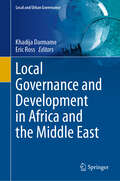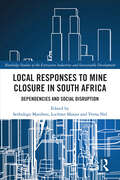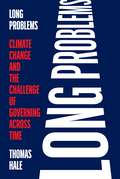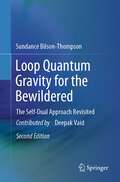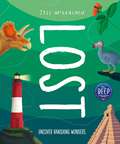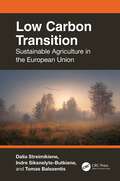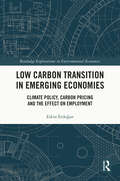- Table View
- List View
Life After Doom: Wisdom and Courage for a World Falling Apart
by Brian D. MclarenWhat does faith look like when cynicism seems more plausible?What does hope look like when hope seems irrational?What does love look like when hate becomes more popular?In recent years, author and activist Brian McLaren has sensed a widespread emotional shift among growing numbers of people. More and more friends, colleagues, students, and readers confess their sense of futility, their feelings of frustration bordering on despair. They feel that human civilization has passed certain tipping points and that a tide of doom is inexorably rising. This feeling creates a deep inner divide, a tension between a sincere and hopeful commitment to action for the common good on the one hand, and on the other, a feeling that no actions can prevent the arrival of an undesirable or even dystopian future.Life After Doom is a sober analysis of how things stand in relation to climate breakdown, and a deeply insightful exploration of the challenge of living well, maintaining resilience and growing in wisdom and love in the face of nations, ecosystems, economies, religions, and other institutions in disarray. Brian McLaren is the author of Faith After Doubt and Do I Stay Christian? and is a leading and authoritative voice at the intersection of religious faith and contemporary culture.'A book of rare wisdom, genuinely profound in depth and scope'DIANA BUTLER BASS
Life After Whale: The Amazing Ecosystem of a Whale Fall
by Lynn BrunelleFollow a blue whale&’s enormous body to the bottom of the ocean, where it sets the stage for a bustling new ecosystem to flourish.All living things must one day die, and Earth&’s largest creature, the majestic blue whale, is no exception. But in nature, death is never a true ending. When this whale closes her eyes for the last time in her 90-year life, a process known as whale fall is just beginning. Her body will float to the surface, then slowly sink through the deep; from inflated behemoth to clean-picked skeleton, it will offer food and shelter at each stage to a vast diversity of organisms, over the course of a century and beyond. Caldecott Medalist Jason Chin&’s astonishing artwork enriches and amplifies engaging, well-researched text by Bill Nye the Science Guy writer Lynn Brunelle. Young lovers of the macabre will relish each page of Life After Whale. Meanwhile, those grappling with the hard subject of death will take solace in this honest look at the circle of life, which closes on a young whale enjoying the same waves as her ancestor. Additional back pages offer further info and reading recommendations on whales, whale falls, and ecosystems.A Junior Library Guild Gold Standard Selection
Life as We Know It (Can Be): Stories of People, Climate, and Hope in a Changing World
by Bill WeirAward-winning journalist and CNN chief climate correspondent Bill Weir draws on his years of immersive travel and reporting to share the best ideas and stories of hope and positivity from the people and communities around the world who are thriving in the wake of climate change, and what we can learn from them to build a more promising future.While reporting from every state and every continent, and filming his acclaimed CNN Original Series The Wonder List, Bill Weir has spent decades telling the stories of unique people, places, cultures, and creatures on the brink of change. As the first Chief Climate Correspondent in network news, he’s immersed in the latest science and breakthroughs on the topic, while often on the frontlines of disasters, natural and manmade.In 2020, Bill began distilling these experiences into a series of Earth Day letters for his then-newborn son to read in 2050, to help him better understand the world he will have grown up in and be better prepared to embrace the future. Bill’s work and his letters were the inspiration for Life As We Know It (Can Be), which confronts the worry and wonder of climate change with messages and examples of hope for all of us on how a better future can still be written.Highlighting groundbreaking innovation in fields of clean energy, food and water sources, housing and building materials, and more, and touching on how happiness, resilience, and health and wellness factor into the topic of climate change, Bill’s stories take readers on a global journey, from one community in Florida that took on a hurricane and never lost power, to the Antarctic Peninsula where one species of penguin is showing us the key to survival, to the nuclear fusion labs where scientists are trying to build a star in a box. In these pages, we join a search for ancient wisdom and new ideas.Life As We Know It (Can Be) is a celebration of the wonders of our planet, a meditation on the human wants and needs that drive it out of balance, and an inspiration for communities to galvanize around nature and each other as the very best way to best prepare and plan for what’s next.
Life in the Wild: Observing the Mysterious Lives of 10 Real Animals
by Lizzie DalyWhat can 10 real-life and uniquely jaw-dropping animal journeys teach us about our world, and the ways in which it is changing?As a filmmaker and scientist, Lizzie Daly tells stories about the natural world and uncovers the hidden secrets of our planet. But despite huge advances in technology, there is still so much we don't know about what species get up to in the wild. However, sometimes—just sometimes—we get a small glimpse into what their lives are like.This book tells the tale of our planet's intriguing wildlife. Through 10 real stories, we follow in the footprints of polar bears, big cats, wolves, and jaguars, and explore oceans with whales, sharks, and seabirds. These tales of migration, mystery, and unique behaviors teach us new and exciting information about animal activity and ecology and give us access to some of the most inhospitable corners of our planet.
Liminality, Transgression and Space Across the World: Being, Living and Becoming(s) Against, Across and with Borders and Boundaries
by Basak Tanulku Simone PekelsmaThis book analyses various forms of liminality and transgression in different geographies and demonstrates how and why various physical and symbolic boundaries create liminality and transgression.Its focus is on comprehending the ways in which these borders and boundaries generate liminality and transgression rather than viewing them solely as issues. It provides case studies from the past and present, allowing readers to connect subjects, periods, and geographies. It consists of theoretical and empirical chapters that demonstrate how borders and liminality are interconnected. The book also benefits from the power of several visual essays by artists to complete the theoretical and empirical chapters which demonstrate different forms of liminality without need of much words.The book will be of interest to researchers and students working in the fields of urban and rural studies, urban sociology, cities and communities, urban and regional planning, urban anthropology, political science, migration studies, human geography, cultural geography, urban anthropology, and visual arts.
Linear Algebra for Earth Scientists
by J. Douglas Walker Noah M. McLeanLinear Algebra for Earth Scientists is written for undergraduate and graduate students in Earth and Environmental sciences. It is intended to give students enough background in linear algebra to work with systems of equations and data in geology, hydrology, geophysics, or whatever part of the Earth Sciences they engage with.The book does not presuppose any extensive prior knowledge of linear algebra. Instead, the book builds students up from a low base to a working understanding of the sub t that they can apply to their work, using many familiar examples in the geosciences.Features Suitable for students of Earth and Environmental Sciences Minimal prerequisites — written in a way that is accessible and engaging for those without a mathematical background All material presented with examples and applications to the Earth Sciences
Linking Climate Change Adaptation, Disaster Risk Reduction, and Loss & Damage
by Linda Anne Stevenson Amit Ranjan Dennis Mombauer Vositha Wijenayake Akio Takemoto Nafesa IsmailThis book advances knowledge on loss & damage (L&D) and its interlinkages with climate adaptation and disaster risk reduction. The book includes twelve case studies conducted across South and Southeast Asia, covering sectors including agriculture, rural livelihoods, energy, infrastructure and natural resources. These studies provide insights into complex climate-induced L&D, enhancing local, national and regional knowledge and contributing to global agendas.
Liquid Architecture: Experimental Practices of Design in a State of Flux (Routledge Research in Architecture)
by Pierangelo Marco ScravaglieriLiquid Architecture challenges the idea of architecture as a fixed, inert container and reconceptualises it as a body whose boundaries are rather blurred and ever-changing. This book moves away from form as the primary driver of spatial protocols and explores what the built environment might look like when viewed through the lenses of a ‘wet ontology’ that is attentive to fluidity, flows and territorial dynamism. A reconfiguration of architectural materials and authorship is thus considered, leading, in turn, to an exploration of the ethical dimensions of co-designing with natural systems (of various viscosities) through liquid paradigms. The book examines a set of principles for practice-led discoveries that incorporate hybrid, mixed media with the author’s intersubjective relationship with liquid matter. Drawing from qualitative-based analytical investigation models, the text allows comprehension of the liquid phenomena via material contextualisation of an ever-becoming research setting. Through a practical and theoretical engagement with the ontology of liquids, the reader is exposed to a range of design-led experiments and creative propositions, visualisation systems, construction, and testing of physical models that collectively translate into a series of novel insights for architectural agendas. This book will be of interest to architecture and design research students and academics because it advocates the need for a more symbiotic and resilient approach to natural systems, which could benefit from the integration of regenerating material flows into our buildings and urban settlements.
Literary Feminist Ecologies of American and Caribbean Expansionism: Errand into the Wilderness (Routledge Environmental Literature, Culture and Media)
by Christine M. Battista Melissa R. SandeThis book synthesizes ecofeminist theory, American studies, and postcolonial theory to interrogate what New Americanist William V. Spanos articulates as the "errand into the wilderness": the ethic of Puritanical expansionism at the heart of the U.S. empire that moved westward under Manifest Destiny to colonize Native Americans, non-whites, women, and the land. The project explores how the legacy of the errand has been articulated by women writers, from the slave narrative to contemporary fiction. Uniting texts across geographical and temporal boundaries, the book constructs a theoretical approach for reading and understanding how women authors craft counter-narratives at the intersection of metaphorical and literal landscapes of colonization. It focuses on literature from the United States and the Caribbean, including the slave narratives by Sojourner Truth, Harriet E. Wilson, and Harriet Jacobs, and contemporary work by Toni Morrison, Maryse Condé, Edwidge Danticat, and Native American writer Linda Hogan. It charts the contrast between America’s earliest idyllic visions and the subsequent reality: an era of unprecedented violence against women of color and the environment. This study of many canonical writers presents an important and illuminating analysis of American mythologies that continue to impact the cultural landscape today. It will be a significant discussion text for students, scholars, and researchers in environmental humanities, ecofeminism, and postcolonial studies.
Little Gardener's First 100 Words
by Tenisha BernalThe perfect primer for budding gardeners, this board book introduces little ones to 100 different items found in the garden!From bugs to tools, each page in this unique first words book is filled with things found in the garden—above and below the ground!Little ones can learn about the parts of a plant, the different herbs, fruits, and vegetables that can grow in a garden, and the names of tools that make gardening easier. There is even a page dedicated to urban gardening for those who don't have yards!Detailed illustrations and brightly colored backgrounds are sure to engage even the youngest of nature enthusiasts. This perfect gift for budding gardeners will show them the tools they need to create and care for their very own garden.
Livable Cities: Urban Heat Islands Mitigation for Climate Change Adaptation Through Urban Greening
by Antonella Trombadore Mohsen Aboulnaga Mona Mostafa Ahmed AbouaianaLivable Cities: Urban Heat Islands Mitigation for Climate Change Adaptation Through Urban Greening elucidates on livability in urban areas, providing readers with definitions and indicators of what makes a city livable. It comprehensively introduces the urban heat island effect (UHIE) and offers strategies for mitigating high surface temperatures in metropolitan areas and adapting to climate change (CC). The coverage highlights the linkage between UHIE and Sustainable Development Goals (SDGs), the socio-economic impacts of urban heat islands (UHIs), their effect on livability for citizens, and the costs and benefits of mitigating UHI. In addition, it encompasses background information about the problems and challenges that megacities face in the 21st century, followed by the cooling benefits that can be achieved from the different types of urban green coverage (UGC), whether conventional or innovative. The book presents case studies on six cities that have successfully applied UGC: Chicago (United States), Curitiba (Brazil), Stuttgart (Germany), Tokyo (Asia), Melbourne (Australia), and Johannesburg (South Africa). Additional case studies illustrate UHIE mapping in greater Cairo, Egypt, and Rome, Italy, to determine hot spot areas that need interventions and prioritization of UGC. Highlights also include the role of blue and green infrastructures in creating livable cities in the post-COVID-19 world, trends of bi-correlation between urban green spaces (UGSs), UGC, and COVID-19, and global patterns of UGSs to shape better healthy, sustainable, and resilient cities. Explains urban heat islands, their causes, and strategies for climate change adaptation to create livable cities; Highlights the role of urban green coverage in post-COVID-19 regulations in shaping more livable, sustainable, and resilient cities.Explores ways to reduce the urban heat island effect by exploiting urban greening to mitigate high temperatures in large cities like Cairo and Rome.
Living Death in Early Modern Drama (ISSN)
by James AlsopThis book explores historical, socio-political, and metatheatrical readings of a whole host of dying bodies and risen corpses, each part of a long tradition of living death on stage.Just as zombies, ghouls, and the undead in modern media often stand in for present-day concerns, early modern writers frequently imagined living death in complex ways that allowed them to address contemporary anxieties. These include fresh bleeding bodies (and body parts), ghostly Lord Mayors, and dying characters who must carefully choose their last words – or have those words chosen for them by the living. As well as offering fresh interpretations of well-known plays such as Middleton’s The Lady’s Tragedy and Webster’s The White Devil, this innovative study also sheds light on less well-known works such as the anonymous The Tragedy of Locrine, Marston’s Antonio’s Revenge, and Munday’s mayoral pageants Chruso-thriambos and Chrysanaleia. The author demonstrates that wherever characters in early modern drama appear to straddle the line between this world and the next, it is rarely a simple matter of life and death.This book will be of great interest to students, scholars, and practitioners in theatre and performance studies, and cultural and social studies.
Living Physical Geography Digital Update
by Bruce GervaisLiving Physical Geography 2e Digital Update helps you understand how people change and are changed by Earth’s physical systems, ranging from local stream erosion to global climate change.
Living with Energy Poverty: Perspectives from the Global North and South (Routledge Explorations in Energy Studies)
by Paola Velasco-Herrejón Breffní Lennon Niall P. DunphyLiving with Energy Poverty: Perspectives from the Global North and South expands our collective understanding of energy poverty and deepens our recognition of the phenomenon by engaging with the lived experiences of energy-poor households across different contexts.Understanding the lived experience of energy poverty is an essential component in the design of any effort to alleviate what is fundamentally a deep-rooted, multi-faceted, wickedly complex problem. This requires a nuanced understanding of the causal factors and the research methods that can respond to the flexible spatial and temporal nature of the condition, as well as its wellbeing and justice implications. Drawing together the expertise and connectedness of authors from the Global South and North, this book presents novel approaches to understanding the often hidden forms of domestic energy deprivation. Case studies from 20 countries provide critical perspectives on this phenomenon while analysing the policy practices, government strategy, and sustainability implications of divergent manifestations. The book takes a multidimensional perspective, challenging the bias towards energy production and service provision, which often do not align with the aspirations and realities of energy households across global contexts, thus facilitating a useful dialogue on the nature of energy poverty.The book is a timely source for policymakers, practitioners, and scholars seeking fresh, diverse insights into the everyday reality of energy poverty and wanting to better understand the challenges a people-centred, just energy transition can present.Chapter 1 of this book is freely available as a downloadable Open Access PDF at http://www.taylorfrancis.com under a Creative Commons [Attribution-Non Commercial-No Derivatives (CC-BY-NC-ND)] 4.0 license.Chapter 2 of this book is freely available as a downloadable Open Access PDF at http://www.taylorfrancis.com under a Creative Commons [Attribution-Non Commercial-No Derivatives (CC-BY-NC-ND)] 4.0 license.Chapter 22 of this book is freely available as a downloadable Open Access PDF at http://www.taylorfrancis.com under a Creative Commons [Attribution-Non Commercial-No Derivatives (CC-BY-NC-ND)] 4.0 license.
Living with Nature, Cherishing Language: Indigenous Knowledges in the Americas Through History
by Justyna Olko Cynthia RaddingThis open access book explores the deep connections between environment, language, and cultural integrity, with a focus on Indigenous peoples from early modern times to the present. It illustrates the close integration of nature and culture through historical processes of environmental change in North, Central, and South America and the nurturing of local knowledge through ancestral languages and oral traditions. This volume fills a unique space by bringing together the issues of environment, language and cultural integrity in Latin American historical and cultural spheres. It explores the reciprocal and necessary relations between language/culture and environment; how they can lead to sustainable practices; how environmental knowledge and sustainable practices toward the environment are reflected in local languages, local sources and local socio-cultural practices. The book combines interdisciplinary methods and initiates a dialogue among scientifically trained scholars and local communities to compare their perspectives on well-being in remote and recent historical periods and it will be of interest to students and scholars in fields including sociolinguistics, (ethno)history, linguistic anthropology, cultural studies and cultural anthropology, environmental studies and Indigenous/minority studies.
Living with Wildlife in Zimbabwe: Navigating Conflict and Co-existence
by Joshua Matanzima Beaven UteteThis book provides a critical analysis of the interactions of humans and wildlife in Zimbabwe. It does not only document conflicts, but it also considers opportunities for co-existence that can result in the successful conservation practices within protected areas. The book offers empirically rich case studies from across different areas of Zimbabwe both urban and rural where people interact with animals both negatively and positively. Chapters in the book discuss these interactions through the different lens including the contemporary politico-economic crises prevalent in Zimbabwe, the failures and successes of the CAMPFIRE programme, and gender dynamics of conflicts. The book provides an update into the human–wildlife interactions situation in Zimbabwe. Data presented has policy implications within Zimbabwe and beyond. It contributes to different categories policy and mitigation measures including HWC mitigation strategies as well as conservation policy. Beaven Utete and Joshua Matanzima have brought together a fascinating collection of papers on human-wildlife conflict and coexistence in Zimbabwe. The authors highlight the views, values and needs of people living with wildlife. Voices that are still too often ignored in conservation practice, policy and science. This is essential reading for anyone interested in decolonizing conservation and the future of wildlife in Africa. Professor Jan van der Ploeg, Professor Inclusive Conservation, Van Hall Larenstein University of Applied Sciences, The Netherlands This is a valuable collection from a country we should hear much more from in the field of human-wildlife interactions studies. In addition to providing interesting case studies and data from Zimbabwe to inform and inspire international conservation efforts, I hope it will galvanize national and local efforts to tackle the complex challenges ahead for biodiversity conservation in Zimbabwe. Professor Simon Pooley, IUCN SSC Specialist Group on Human-Wildlife Conflict and Coexistence
Local Climate Zone Application in Sustainable Urban Development: Experience from East and Southeast Asian High-Density Cities
by Ran Wang Chao Ren Meng Cai Yuan ShiThe study of local climate zones (LCZ) links urban morphology, land use and land cover types, human activity, and thermal properties, and provides a standard framework for studying urban climatic issues. In recent years, the LCZ scheme attracts more and more attention from climatologists, urban planners, environmental engineers, as well as architects due to its combination of urban climatic scientific research outputs and urban planning and morphology language. Urbanization and higher-density living, an ongoing and continued path of human development, brings various urban climatic and environmental problems. Urban development in a sustainable way is vital for high-density cities to build a comfortable living environment.This book is the first one presenting systematically the latest LCZ applications by taking Asian high-density cities as an example. Generally, four parts are introduced and discussed in this book. At first, a general background of urbanization and its impacts is introduced, and the basic knowledge of LCZ. The second part introduces the methodology and techniques of LCZ data development. In the third part, various applications of LCZ are demonstrated in practice, including application to urban heat island, land use and land cover analysis, wind environment, energy consumption, thermal comfort studies and so on. Lastly, this book concludes the progress, challenges, limitations, and future work of LCZ-related studies.The book will be of interest to all that are working on or interested in urban climate, sustainable urban development, and policy-making.
Local Governance and Development in Africa and the Middle East (Local and Urban Governance)
by Eric Ross Khadija DarmameThis edited volume surveys how current local governance policies and development strategies across Africa and the Middle east are advancing Sustainable Development Goals (SDGs). Morocco's recent experience with local development strategies serves as starting point for the discussion. Over the past decade, Morocco has undertaken a variety of initiatives aimed at reducing poverty and social inequalities and providing essential services to marginalized communities. These initiatives provide great opportunities to reshape the spatial organization of regions, and to address chronic local issues of infrastructure and investment. Local governance is the most direct way of providing basic services to populations, helping to alleviate socio-spatial inequalities. Also, it is and will continue to be the best way to engage people and local governments in economic, social and human development agendas. However, placing local governance at the heart of development strategies requires going well beyond participatory approaches to policy making. Local communities and their governments need to be empowered. As responses to the Covid19 epidemic have laid bare, new and more efficient modes of territorial governance are needed at local and regional levels if current global-scale challenges are to be met. While development and governance strategies like Morocco's are framed by global agreements and standards, there is a need to understand them at the regional scale. Are there discernible patterns in how African and Middle Eastern countries design and implement them? This volume assembles case studies from across the region, allowing for understandings that transcend the usual spatial dichotomies between "North" and "Sub-Saharan" Africa, between Africa and the Middle East, and between the "Anglophone" and "Francophone" spheres. The volume builds upon an international conference on the topic held at Al Akhawayn University in Ifrane, Morocco Morocco in February of 2022. The volume is aimed at a readership of researchers and development practitioners, and will be of most direct benefit to advanced undergraduate and graduate-level students.
Local Responses to Mine Closure in South Africa: Dependencies and Social Disruption (Routledge Studies of the Extractive Industries and Sustainable Development)
by Sethulego Matebesi Lochner Marais Verna NelThis book investigates mine closure and local responses in South Africa, linking dependencies and social disruption. Mine closure presents a major challenge to the mining industry and government policymakers globally, but particularly in the Global South. South Africa is experiencing notable numbers of mine closures, and this book explores the notion of social disruption, a concept often applied to describe the effects of mine growth on communities but often neglecting the impact of mine closures. The book begins with three theoretical chapters that discuss theory, closure cost frameworks and policy development in South Africa. It uses evolutionary governance theory to show how mining creates dependencies and how mining growth often blinds communities and governments to the likelihood of closure. Too easily, mining goes ahead with no concern for the possibility, or indeed inevitability, of eventual closure and how mining communities will cope. These impacts are showcased through eight place-based case studies from across South Africa, one focusing on mine workers, to demonstrate that mine closure causes significant social disruption. This book will be of interest to students and scholars researching the social impacts of mining and the extractive industries, social geography and sustainable development, as well as policymakers and practitioners working with mine closure and social impact assessments.
Long Problems: Climate Change and the Challenge of Governing across Time
by Thomas HalePolitical strategies for tackling climate change and other &“long problems&” that span generationsClimate change and its consequences unfold over many generations. Past emissions affect our climate today, just as our actions shape the climate of tomorrow, while the effects of global warming will last thousands of years. Yet the priorities of the present dominate our climate policy and the politics surrounding it. Even the social science that attempts to frame the problem does not theorize time effectively. In this pathbreaking book, Thomas Hale examines the politics of climate change and other &“long problems.&” He shows why we find it hard to act before a problem&’s effects are felt, why our future interests carry little weight in current debates, and why our institutions struggle to balance durability and adaptability. With long-term goals in mind, he outlines strategies for tilting the politics and policies of climate change toward better outcomes.Globalization &“widened&” political problems across national boundaries and changed our understanding of politics and governance. Hale argues that we must make a similar shift to understand the &“lengthening&” of problems across time. He describes tools and strategies that can, under certain conditions, allow policymakers to anticipate future needs and risks, make interventions that get ahead of problems, shift time horizons, adapt to changing circumstances, and set forward-looking goals that endure. As the climate changes, politics must, too. Efforts to solve long-term problems—not only climate change but other issues as well, including technology governance and demographic shifts—can also be a catalyst for a broader institutional transformation oriented toward the long term. With Long Problems, Hale offers an essential guide to governing across time.
Loop de Loop: Circular Solutions for a Waste-Free World
by Andrea CurtisGet loopy with this playful introduction to the hopeful, transformative possibilities of circular systems! Nature works on a cycle, where everything in the loop has value and nothing is wasted. But modern humans have created a different kind of system: it’s less like a circle and more like a line. We take, make, use and then, when those things break or we’re finished with them, we toss them away. But our planet’s resources are limited, and we’ve taken too much. That’s why all over the world, people are reusing, repurposing, repairing and designing waste out of the system! Explore the ways that people everywhere are creating a loopier world: from growing building materials out of fungi to designing headphones (and cellphones!) that last, to producing vehicles that run on renewable energy. Plus, kids and families have a role to play, too. Loop de Loop introduces young readers to repair cafés, toy rentals, tool libraries and many more fun, innovative ways to build community and a more sustainable world. Includes a list of ways children can take part in circular systems, along with a glossary and sources for further reading. Key Text Features Illustrations glossary definitions further reading Correlates to the Common Core State Standards in English Language Arts: CCSS.ELA-LITERACY.RI.K.8 With prompting and support, identify the reasons an author gives to support points in a text. CCSS.ELA-LITERACY.RI.1.2 Identify the main topic and retell key details of a text.
Loop Quantum Gravity for the Bewildered: The Self-Dual Approach Revisited
by Sundance Bilson-ThompsonThis second edition offers a comprehensive introduction to loop quantum gravity (LQG) in self-dual variables, including the necessary prerequisites. Additionally, it delves into various significant research areas that have emerged in recent years. New content (including an entirely new chapter dedicated to dynamics of quantum spacetime) explores the description of spin networks and spin-foams, their historical development as well as connections to tensor networks, BF theory, and emerging approaches including the spinorial representation of LQG, SU(2) coherent states, and group field theory. Furthermore, the book provides expanded appendices covering essential tools and concepts, such as the connection between information theory and entropy, and overviews of group theory and differential geometry. All topics are presented from a non-expert perspective, ensuring self-containment and accessibility. The primary aim of this second edition remains helping researchers, bewildered bythe vast array of topics within this rapidly growing field of quantum gravity, to gain a fundamental understanding of the current developments.
Lost: Discover disappearing wonders
by Jess McGeachinA book that explores what it means to be lost, in all sorts of ways. The story of our world is one of constant change. At times it's been slow, as animals evolved and continents drifted apart. But it's also been rapid - like the giant asteroid that ended the reign of the dinosaurs. Lost asks readers what it means to be here and gone on our tiny planet. They'll find lost cities like Machu Picchu and Pompeii, meet amazing megafauna that once roamed the earth and learn about contemporary species under threat. They'll discover that sometimes being lost the safest place to be - just ask the cleverly camouflaged animals hiding in plain sight.
Low Carbon Transition: Sustainable Agriculture in the European Union
by Dalia Streimikiene Indre Siksnelyte-Butkiene Tomas BalezentisLow-carbon transition is a shift from an economy that depends heavily on fossil fuels to a sustainable, low-carbon energy economy. This book analyzes the role of renewables in driving the low-carbon transition in agriculture, explores the circular bio-based economy, and examines policies and strategies designed to facilitate low-carbon transition in agriculture, greenhouse gas mitigation, and adaptation trends in the European Union agriculture sector. It provides new knowledge and understanding about the impact of low-carbon energy transition, emphasizes the key role of renewable energy in a wide range of agricultural activities, and offers alternative sustainable solutions to current practices.Features Discusses a novel approach on low-carbon transition that is not considered by the majority of studies Emphasizes the urgent need to minimize the carbon and environmental footprint of the EU agriculture and food system through low-carbon energy transition Provides theoretical background of sustainable agriculture and explains the decarbonization path of agriculture. Investigates the role of renewables, new technologies, business models, and practices in agriculture while assessing their socioeconomic and environmental effects. Presents a case study on the applications of low-carbon transition policies in selected EU member states and analyses in details various implications. This book is suitable for senior undergraduate and graduate students, professionals in agriculture, researchers, and policy makers interested in sustainable agriculture and renewable energy usage and their economics.
Low Carbon Transition in Emerging Economies: Climate Policy, Carbon Pricing and the Effect on Employment (Routledge Explorations in Environmental Economics)
by Erkin ErdoğanMany emerging economies are in the front line of the devastating impacts of global warming such as desertification and extreme weather events but, for historical and political reasons, they follow ambitious growth targets with seemingly little concern for climate change and environmental degradation. Focusing on the case of Turkey, this book investigates the economic impacts of possible climate change policies to help meet the required mitigation targets and transition to a low carbon economy. In order to reach the net-zero targets by 2050 in compliance with the Paris Agreement, Turkey must introduce policies that promote low carbon investments, green jobs and low carbon employment more broadly. This book explores the empirical evidence on the effectiveness of a carbon pricing mechanism by developing an econometric VAR model to analyse key data sets. This time series analysis provides insights on a macro level, dealing with aggregate data in which the role and complexity of micro interferences disappears, allowing for the discovery of patterns and changes over time. Thus, the book contributes to the literature on methodology by arguing that time series analysis is one of the best fitting approaches to estimate possible impacts of climate change policies in an economy. Additionally, the results of the model are compared and contrasted with similar data from other emerging economies to identify potential common policy solutions between countries at a similar stage of development. This book is vital reading for researchers interested in climate policy, the economics of climate change and environmental economics.
